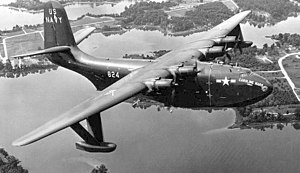| JRM Mars | |
|---|---|
 JRM-2 Mars "Caroline Mars" in US Navy service | |
| General information | |
| Type | Flying boat |
| National origin | United States |
| Manufacturer | Glenn L. Martin Company |
| Status | Retired |
| Primary users | United States Navy (historical)
|
| Number built | 7 |
| History | |
| Manufactured | 1945–1948 |
| Introduction date | 30 November 1943 |
| First flight | 23 June 1942 |
| Retired | 1956 (USN) 2024 (Civilian) |
| Developed into | Martin 193 |
The Martin JRM Mars is a large, four-engined cargo transport flying boat designed and built by the Martin Company for the United States Navy during World War II. It was the largest Allied flying boat to enter production, although only seven were built. The United States Navy contracted the development of the XPB2M-1 Mars in 1938 as a long-range ocean patrol flying boat, which later entered production as the JRM Mars long-range transport.
Four of the surviving aircraft were later converted for civilian use to firefighting water bombers. Two of the aircraft remained based at Sproat Lake just outside of Port Alberni, British Columbia, with one, the "Hawaii Mars", remaining in operation until 2016. On March 28, 2024, the British Columbia Aviation Museum announced it acquired the aeroplane from Coulson Aviation. It flew on its last flight to Victoria on August 11, 2024. On the evening of Wednesday, August 21, 2024, just after 9:00 pm, the "Hawaii Mars" was on a 360-degree rotating trailer as it crept across the active taxiways of Victoria Airport towards the British Columbia Aviation Museum. It will become part of a permanent display there, taking the museum's "Crown Jewel" title. [1]
On April 25, 2024, it was announced that "Philippine Mars" will be acquired by the Pima Air and Space Museum in Tucson, Arizona to be put on permanent display there.[2] It is due to be flown there later in the year. It entered the Sproat Lake water for powered testing November 04, 2024. [3]
- ^ "Historic B.C. Martin Mars water bomber will fly one last time". Alberni Valley News. 2024-03-28. Retrieved 2024-04-02.
- ^ "Coulson Aviation's Philippine Mars Waterbomber to land permanently at Arizona museum". CHEK. 2024-04-25. Retrieved 2024-04-25.
- ^ https://vintageaviationnews.com/warbirds-news/phillipine-mars-begins-water-trials.html